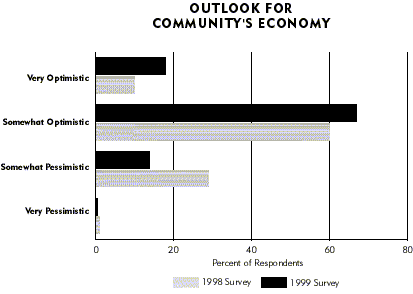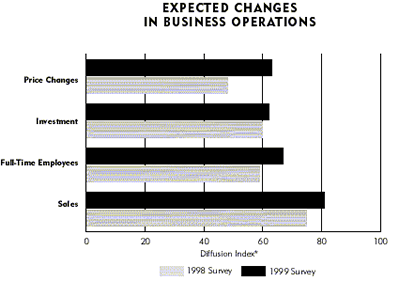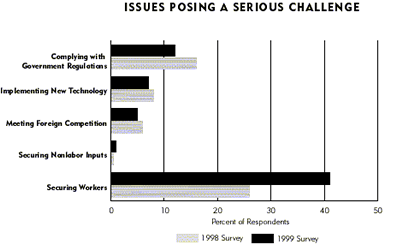Ninth District business leaders expect the nine-year economic expansion to continue into the new millennium. Most of the 203 respondents to the November business poll are more optimistic about the economy than they were last year.
Business leaders are also more optimistic about their own company operations than they were last year. Positive changes in companies' operations are expected in 2000 for sales, employment and investment. However, a serious challenge facing businesses in 2000 is securing workers. Over 90 percent of respondents indicated it would be a challenge to hire and retain workers, which is spilling into higher wage increases compared to last year.
In addition to their own company prospects, business leaders are more optimistic about their community and the national economy. Eighty-five percent of respondents are optimistic about the 2000 economic prospects for their community, compared to 70 percent in last year's poll. While many business leaders are more optimistic than last year in business investment, employment and consumer spending, more are pessimistic about housing starts. Essentially all business leaders expect continued economic growth nationally in 2000 and most expect prices to increase more than 2 percent.
In 2000...

Business leaders are more optimistic about the prospects for the 2000 economy: 85 percent polled this year are optimistic compared to 70 percent in last year's poll.

Regarding their own businesses, respondents are slightly more optimistic than last year. Investments, employment and sales are expected to increase at faster levels than last year. In addition, business leaders anticipate raising prices in 2000.

In addition to price hikes, business leaders expect to pay more for labor. Over 40 percent of respondents expect to raise wages 4 percent or more next year, a significant increase from last year's poll, while half plan to raise wages in the 2 percent to 3 percent range.

Increasing wages are a response to the biggest challenge facing businesses—securing workers. Over 40 percent of respondents expect a serious challenge to find workers for their companies in 2000, a 15 percentage point increase from last year's poll; another 50 percent said it would be a challenge However, only 12 percent of respondents indicated that complying with government regulations was a serious challenge, a 4 percentage point drop from last year's poll.
*The diffusion index measures the dispersion among respondents on how they see components of their economy changing over the next year. Each component is assigned a value of 0, 50 or 100 percent, depending on whether it is expected to decrease, not change or increase. The average value is the diffusion index number. The reference point for interpreting the diffusion index is 50 percent, the value which indicates that the same number of respondents expect an increase as a decrease. The direction and distance of the index number from the 50 percent indicate whether increasing (above 50) or decreasing (below 50) opinions predominate and by what magnitude.
Complete Survey [xls]





